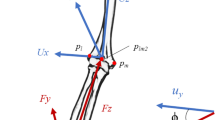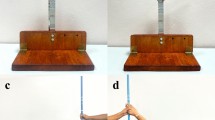Abstract
Background
A universal goniometer is commonly used to measure the elbow’s ROM and carrying angle; however, some authors question its poor intertester reliability.
Questions/purposes
We (1) assessed the validity of goniometric measurements as compared with radiographic measurements in the evaluation of ROM of the elbow and (2) determined the reliability of both.
Methods
The ROM and carrying angle of 51 healthy subjects (102 elbows) were measured using two methods: with a universal goniometer by one observer three times and on radiographs by two independent examiners. Paired t-test and Pearson’s correlation were used to compare and detect the relationship between mean ROM. The maximal error was calculated according to the Bland and Altman method.
Results
The intraclass correlation coefficients (ICC) ranged from 0.945 to 0.973 for the goniometric measurements and from 0.980 to 0.991 for the radiographic measurements. The two methods correlated when measuring the total ROM in flexion and extension. The maximal errors of the goniometric measurement were 10.3° for extension, 7.0° for flexion, and 6.5° for carrying angle 95% of the time. We observed differences for maximum flexion, maximal extension, and carrying angle between the methods.
Conclusion
Both measurement methods differ but they correlate. When measured with a goniometer, the elbow ROM shows a maximal error of approximately 10°.
Clinical Relevance
The goniometer is a reasonable and simple clinical tool, but for research protocols, we suggest using the radiographic method because of the higher level of precision required.



Similar content being viewed by others
References
Armstrong AD, MacDermid JC, Chinchalkar S, Stevens RS, King GJ. Reliability of range-of-motion measurement in the elbow and forearm. J Shoulder Elbow Surg. 1998;7:573–580.
Awan R, Smith J, Boon AJ. Measuring shoulder internal rotation range of motion: a comparison of 3 techniques. Arch Phys Med Rehabil. 2002;83:1229–1234.
Bland JM, Altman DG. A note on the use of the intraclass correlation coefficient in the evaluation of agreement between two methods of measurement. Comput Biol Med. 1990;20:337–340.
Bland JM, Altman DG. Applying the right statistics: analyses of measurement studies. Ultrasound Obstet Gynecol. 2003;22:85–93.
Boone DC, Azen SP. Normal range of motion of joints in male subjects. J Bone Joint Surg Am. 1979;61:756–759.
Docherty MA, Schwab RA, Ma OJ. Can elbow extension be used as a test of clinically significant injury? South Med J. 2002;95:539–541.
Fish DR, Wingate L. Sources of goniometric error at the elbow. Phys Ther. 1985;65:1666–1670.
Glasgow C, Wilton J, Tooth L. Optimal daily total end range time for contracture: resolution in hand splinting. J Hand Ther. 2003;16:207–218.
Golden DW, Wojcicki JM, Jhee JT, Gilpin SL, Sawyer JR, Heyman MB. Body mass index and elbow range of motion in a healthy pediatric population: a possible mechanism of overweight in children. J Pediatr Gastroenterol Nutr. 2008;46:196–201.
Goodwin J, Clark C, Deakes J, Burdon D, Lawrence C. Clinical methods of goniometry: a comparative study. Disabil Rehabil. 1992;14:10–15.
Greene BL, Wolf SL. Upper extremity joint movement: comparison of two measurement devices. Arch Phys Med Rehabil. 1989;70:288–290.
Gunal I, Kose N, Erdogan O, Gokturk E, Seber S. Normal range of motion of the joints of the upper extremity in male subjects, with special reference to side. J Bone Joint Surg Am. 1996;78:1401–1404.
Hayes K, Walton JR, Szomor ZR, Murrell GA. Reliability of five methods for assessing shoulder range of motion. Aust J Physiother. 2001;47:289–294.
Jaeger GH, Marcellin-Little DJ, Depuy V, Lascelles BD. Validity of goniometric joint measurements in cats. Am J Vet Res. 2007;68:822–826.
Lee J, Koh D, Ong CN. Statistical evaluation of agreement between two methods for measuring a quantitative variable. Comput Biol Med. 1989;19:61–70.
Lennon RI, Riyat MS, Hilliam R, Anathkrishnan G, Alderson G. Can a normal range of elbow movement predict a normal elbow x ray? Emerg Med J. 2007;24:86–88.
London JT. Kinematics of the elbow. J Bone Joint Surg Am. 1981;63:529–535.
Macedo LG, Magee DJ. Differences in range of motion between dominant and nondominant sides of upper and lower extremities. J Manipulative Physiol Ther. 2008;31:577–582.
Macedo LG, Magee DJ. Effects of age on passive range of motion of selected peripheral joints in healthy adult females. Physiother Theory Pract. 2009;25:145–164.
Mayerson NH, Milano RA. Goniometric measurement reliability in physical medicine. Arch Phys Med Rehabil. 1984;65:92–94.
Morrey BF, Sanchez-Sotelo J. The Elbow and its Disorders. Ed 4. Philadelphia, PA: Saunders Elsevier; 2008.
Paraskevas G, Papadopoulos A, Papaziogas B, Spanidou S, Argiriadou H, Gigis J. Study of the carrying angle of the human elbow joint in full extension: a morphometric analysis. Surg Radiol Anat. 2004;26:19–23.
Park W, Ramachandran J, Weisman P, Jung ES. Obesity effect on male active joint range of motion. Ergonomics. 2010;53:102–108.
Petherick M, Rheault W, Kimble S, Lechner C, Senear V. Concurrent validity and intertester reliability of universal and fluid-based goniometers for active elbow range of motion. Phys Ther. 1988;68:966–969.
Pique-Vidal C, Maled-Garcia I, Arabi-Moreno J, Vila J. Radiographic angles in hallux valgus: differences between measurements made manually and with a computerized program. Foot Ankle Int. 2006;27:175–180.
Riddle DL, Rothstein JM, Lamb RL. Goniometric reliability in a clinical setting: shoulder measurements. Phys Ther. 1987;67:668–673.
Rothstein JM, Miller PJ, Roettger RF. Goniometric reliability in a clinical setting: elbow and knee measurements. Phys Ther. 1983;63:1611–1615.
Shaaban H, Pereira C, Williams R, Lees VC. The effect of elbow position on the range of supination and pronation of the forearm. J Hand Surg Eur Vol. 2008;33:3–8.
Shiba R, Sorbie C, Siu DW, Bryant JT, Cooke TD, Wevers HW. Geometry of the humeroulnar joint. J Orthop Res. 1988;6:897–906.
Steindler A. Kinesiology of the Human Body Under Normal and Pathological Conditions. Ed 5. Springfield, IL: Charles C. Thomas; 1977.
Szulc P, Lewandowski J. Verification of selected anatomical landmarks used as reference points for universal goniometer positioning during elbow joint mobility range measurements. Folia Morphol (Warsz). 2003;62:353–355.
Terwee CB, De Winter AF, Scholten RJ, Jans MP, Deville W, van Schaardenburg D, Bouter LM. Interobserver reproducibility of the visual estimation of range of motion of the shoulder. Arch Phys Med Rehabil. 2005;86:1356–1361.
van de Pol RJ, van Trijffel E, Lucas C. Inter-rater reliability for measurement of passive physiological range of motion of upper extremity joints is better if instruments are used: a systematic review. J Physiother. 2010;56:7–17.
Zampagni ML, Casino D, Zaffagnini S, Visani AA, Marcacci M. Estimating the elbow carrying angle with an electrogoniometer: acquisition of data and reliability of measurements. Orthopedics. 2008;31:370.
Author information
Authors and Affiliations
Corresponding author
Additional information
Each author certifies that he or she has no commercial associations (eg, consultancies, stock ownership, equity interest, patent/licensing arrangements, etc) that might pose a conflict of interest in connection with the submitted article.
Each author certifies that his or her institution approved the human protocol for this investigation, that all investigations were conducted in conformity with ethical principles of research, and that informed consent for participation in the study was obtained.
This work was performed at the Hôpital du Sacré-Cœur de Montreal, Quebec, Canada.
About this article
Cite this article
Chapleau, J., Canet, F., Petit, Y. et al. Validity of Goniometric Elbow Measurements: Comparative Study with a Radiographic Method . Clin Orthop Relat Res 469, 3134–3140 (2011). https://doi.org/10.1007/s11999-011-1986-8
Received:
Accepted:
Published:
Issue Date:
DOI: https://doi.org/10.1007/s11999-011-1986-8




